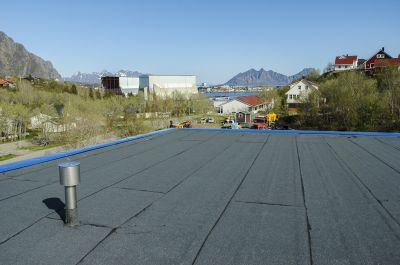Top Products For Roof Flashing Replacements To Ensure Durability
Explore the leading options for roof flashing replacements that enhance weather resistance and extend your roof's lifespan.
 Roof flashing replacements are essential components in maintaining the integrity and longevity of a roof. Flashing serves as a barrier that directs water away from vulnerable areas such as joints, chimneys, vents, and valleys, preventing leaks and water damage. When existing flashing becomes damaged, corroded, or improperly installed, it can compromise the roof's effectiveness, leading to potential structural issues. Selecting the right replacement materials is crucial for ensuring a durable, weather-resistant seal that withstands the elements over time.
Roof flashing replacements are essential components in maintaining the integrity and longevity of a roof. Flashing serves as a barrier that directs water away from vulnerable areas such as joints, chimneys, vents, and valleys, preventing leaks and water damage. When existing flashing becomes damaged, corroded, or improperly installed, it can compromise the roof's effectiveness, leading to potential structural issues. Selecting the right replacement materials is crucial for ensuring a durable, weather-resistant seal that withstands the elements over time.
Top Overall Option
Metal Roof Flashing Sheets
Metal roof flashing sheets are a versatile and durable choice for many roofing applications. They come in various metals such as aluminum, copper, and galvanized steel, offering options that suit different aesthetic preferences and durability requirements. These sheets are available in multiple gauges and sizes, allowing for customization to fit specific roof features. Easy to cut and shape, metal flashing sheets provide a seamless and weather-resistant barrier that can be detailed to match the contours of the roof, making them a practical choice for both new installations and repairs.
Types of Products For Roof Flashing Replacements
L-Shaped Metal Flashing
L-shaped metal flashing is commonly used along roof edges and valleys to provide a protective barrier against water intrusion.
Step Flashing
Step flashing is installed in individual sections along roof joints and chimneys to direct water away from seams.
Continuous Flashing
Continuous flashing runs along long sections of the roof, offering a seamless water-resistant barrier.
Base Flashing
Base flashing is installed at the intersection of the roof and vertical surfaces like walls or chimneys.
Valley Flashing
Valley flashing is designed to channel water away from roof valleys where two roof planes meet.
Pipe Flashing Boots
Flexible rubber or silicone boots that seal around vent pipes and other protrusions.
Roof Vent Flashing
Specialized flashing designed to seal around roof vents and exhaust pipes.
Skirt Flashing
Skirt flashing is used around chimneys, skylights, and other roof penetrations for added protection.
Flexible Rubber Flashing
Flexible rubber flashing provides adaptable sealing around irregular shapes and penetrations.
Pre-Formed Corner Flashing
Pre-formed corner pieces designed to fit neatly at roof intersections and angles.
Aluminum Flashing Tape
Self-adhesive aluminum tape for quick sealing and patching of small areas.
Copper Flashing
Copper flashing offers a corrosion-resistant option with an attractive appearance, suitable for decorative or traditional roofs.
Galvanized Steel Flashing
Galvanized steel provides strength and corrosion resistance, ideal for high-wear areas.
Flexible Sealant and Caulking
Sealants and caulks are used to fill gaps and ensure watertight seals around flashing components.
Popular Choices
Widely used for their durability and versatility, suitable for various roof styles and repairs.
Popular for chimney and roof joint sealing, offering pre-cut pieces for easier installation.
Commonly selected for sealing around vent pipes and roof penetrations.
Favored for their adaptability around irregular shapes and penetrations.
Popular for quick repairs and sealing small gaps with ease.
Chosen for its corrosion resistance and aesthetic appeal in traditional roofing styles.
A durable option for high-stress areas prone to corrosion.
Essential for directing water away from roof valleys, preventing leaks.
Commonly used for sealing around exhaust and ventilation pipes.
Often selected for chimney and skylight sealing to prevent water intrusion.
Popular for neatly finishing roof intersections and angles.
Widely used for sealing small gaps and ensuring watertight finishes around flashing.
There is a wide variety of flashing products available, each suited to different roofing styles, materials, and installation preferences. Metal options like aluminum, copper, and galvanized steel are common choices due to their strength and corrosion resistance. Rubber and flexible membrane flashings are often used for irregular shapes or around vents and pipes, providing a customizable fit. Proper installation and material compatibility are key factors in achieving optimal performance, making it important to consider the specific requirements of your roof when choosing replacement flashing.
In addition to material considerations, the size, thickness, and design of flashing products can influence their effectiveness and ease of installation. Some products come with pre-formed shapes for common roof features, while others may require cutting and shaping on-site. Ensuring compatibility with existing roofing materials and the local climate can help prolong the lifespan of the flashing. Regular inspection and timely replacement of damaged flashing can prevent costly repairs and preserve the roof's protective barrier for years to come.
Ultimately, investing in quality roof flashing replacement products can contribute to the overall durability and weatherproofing of your home. Whether you're undertaking a minor repair or a major roof overhaul, understanding the options available can help you select the most suitable materials for your specific roofing needs.
Key Buying Considerations
- Material durability and corrosion resistance suitable for your climate.
- Compatibility with existing roofing materials and structures.
- Appropriate thickness and gauge for the specific application.
- Ease of installation, especially if DIY-ing the repair.
- Flexibility and ability to conform to roof contours and penetrations.
- UV resistance for long-term outdoor exposure.
- Availability of pre-formed shapes for common roof features.
- Compatibility with existing flashing or roofing components.
- Weather resistance, including resistance to rain, snow, and wind.
- Aesthetic considerations if visible from the ground or roofline.
- Cost-effectiveness balanced with quality and longevity.
- Availability of sealing accessories like caulks and tapes.
- Ease of cutting and shaping for custom fits.
- Manufacturer reputation and product reviews.
- Warranty or guarantee offered by the supplier.
